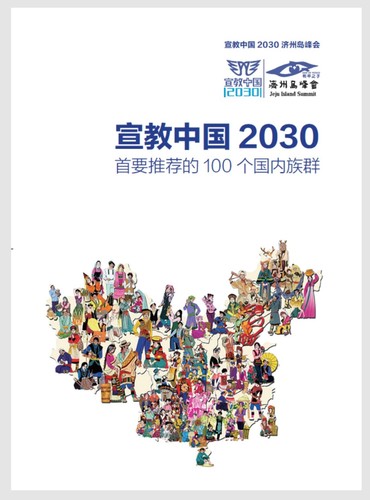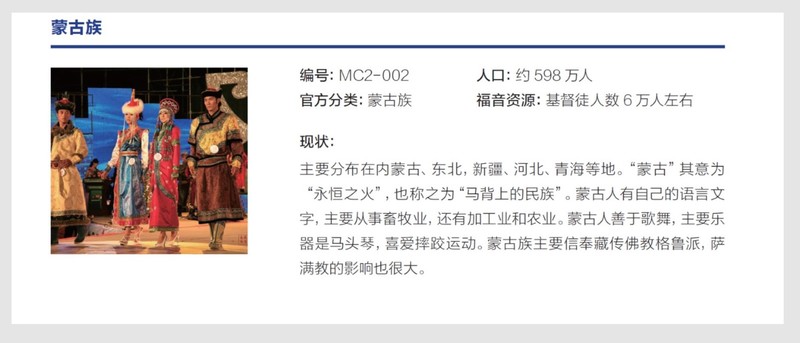
The church in China is riding high as if surfing the tsunami of mission awareness and endeavor. At the height of every wave, one can see an increasing, widespread, interest in mission work among the churches in China. As part of this interest, there are more and more activities and publications that feed the thirst and hunger of their huge appetite for missions. Mission China 2030 is but one of the several major events addressing this.[1]
During the recent Mission China 2030 conference held last September, a prayer guide listing the top 100 unreached people groups (UPG) in China was distributed to all 800-plus participants. The purpose of the book is to encourage the churches represented at the conference to each adopt one group before the end of the gathering.
As far as this reviewer is aware, this book is the first of its kind published in China that focuses on unreached people groups within China.[2] All previous publications were in the form of occasional articles or magazines (a magazine was published for only several issues some fifteen years ago and then stopped). This book is the first attempt to put together a comprehensive list of UPGs and highlights the top 100 priority groups to be adopted. While edited by two of the most seasoned UPG researchers in China, they have opted to not give their names or any publishing information.[3] Nevertheless, these two researchers must be commended for putting together such urgently needed information and placing it before the church.
The first section, “Who Will Care for Us” is the lead article on the status of evangelization among minority people groups. Occupying almost one quarter of the book, this summary is based on three published articles by a well-known Chinese missiologist and is an expanded version put together by him. It is a comprehensive overview of missions among minorities. The following is an abridged outline:
- Religious beliefs in general of each minority.
- Vision for mission to reach minorities, most of whom live in western China.
- Status of mission to the minorities:
- History of mission to minorities; focus is on development over the last twenty years.
- Positive factors for mission to minorities: a vision from God; strong commitment; focus on the short term; financial support.
- Negative factors for mission to minorities: groups working independently of each other; lack of training; deficiency of strategy; need for ministry platform; financial dependency; lack of supervision and care.
- Attitude of missionaries: Confession of historical treatment of minorities by the Han majority; love and concern for their souls; honoring their culture; incarnational ministry.
- Challenge of mission to minorities: governmental, political, and religious pressures; difficulty of pastoral and discipleship ministries due to accessibility; training and leadership development for minority believers; training of missionaries to be sent from the minorities; perfecting of mission sending structures; feasibility study of mission strategy.
- Suggested strategy for mission to minorities: overview of steps for adopting a UPG; specific strategies including:
- Indigenous mission movement.
- Dual track covering both cultural mandate and evangelistic mandate.
- Professional service.
- Partnership with the indigenous church.
- Linguistic and literature ministries including Bible translation.
- Contextualization issues.
- Top-down and bottom-up strategies (between societal elites and grass-root class).
It is worth noting that this missiologist includes the issue of minorities being historically mistreated by the Han majority (point #4 above). To the reviewer’s knowledge, this is the first time a Han Chinese missiologist has suggested it as an important issue to be addressed. Most Chinese mission leaders do not consider this. Nevertheless, the author stops short of suggesting the importance of doing ministry in the heart language of the minorities, stating instead that their leadership training can be conducted in Mandarin alone. The author also gives some practical steps on adopting a UPG, starting with research and prayer, moving on to the training and sending of missionaries, and finally, passing the church to the local believers.
Section two continues with the100 priority minority UPGs and takes up almost another quarter of the book. It lists 103 UPGs that are clearly identified as being recommended by the Mission China 2030 conference for adoption by a church. A typical introduction to an UPG includes:
- Name and picture,
- Population,
- Official government designation (one of 55 official minorities or “unrecognized” as one of the 60-plus designated minorities in the 2010 census),
- Christian resources available about the UPG (including number of believers),
- Short description of general livelihood.

This list contains the most obvious UPGs with huge populations of ten million or more such as the Hui, Uygurs, and Zhuang. There are however, some surprises. Some very small UPGs are listed with populations as little as 300 (see entry MC2-055 Lao Pin people老品人 with 233 people). No explanation is given for the criteria used to put the groups in order. Rather, the list appears to be ordered randomly, not according to pinyin or population size.
Section three contains a short article outlining how the Chinese government conducted its people group research in each unique societal and historical setting. Written by another Chinese missiologist, it is titled “To Search for the Lost Minority.” In this detailed analysis, the unspoken assumptions of the government’s minority policy are clearly identified—that the majority Han people is superior, and the Chinese worldview is that of being the central kingdom. It shows how government policy since the 1950s is based on these assumptions and how geographical residence became the dominating factor in people group classification with other cultural factors becoming considerations later in the process.
Section four, covering most of the remaining half of the book, provides more detailed information on each people group, its culture, language, religion, geographical spread and some prayer points. However, it lists UPGs according to the Chinese reader’s mindset—in the order of their provincial residence. So the same UPG can be listed twice if they live in two different provinces (eg. the Cai people are listed under Yunnan Province as entry 11.54 with the population in Yunnan and again under Guizhou as entry 12.83 with the population in Guizhou). This arrangement carries an implicit message that is contrary to conventional cross-cultural mission—that the same people group requires different strategies if it is in different provinces.
However, that is not the most serious flaw of the book. One would expect the UPGs in Sections two and four to match each other, but a careful reading shows that the two sections seem to come from different sources. The UPGs overlap by only a little over 20 groups. To make matters more confusing, there is no cross-reference system between the two sections. So, the average reader is left to figure out on his own if UPG MC2-062 in section two is the same as 6.18 in section four, both being the same Deng people (僜) in Tibet. However, the detailed information given in the two sections is not always the same; the Deng people have a population of 2000 in section two but 20,000 in section four.
As the first attempt to put together such information, the book is a qualified success. It certainly points out the need and a practical way to engage minority UPGs for the church in China. However, much editorial work is needed to make it more useful. This reviewer has identified the following areas where more work is needed.
- Clear criteria of how these 100 UPGs were selected.
- One list of the 100 UPGs used in sections two and four instead of two lists.
- A cross-reference system between sections two and four.
- No conflicting information between the two sections.
- Whether it is necessary to list the same people group under different provinces.
In addition, under each group description (perhaps in section two), a small map indicating where the UPG is living would provide the average church leader a deeper understanding of the group.
I look forward to the book being revised and becoming a standard tool to encourage churches in China to adopt in-country UPGs as part of their involvement in missions.
Wei Ver
Wei Ver (pseudonym) has extensive Chinese ministry experience and now focuses on helping China as a sending nation.View Full Bio